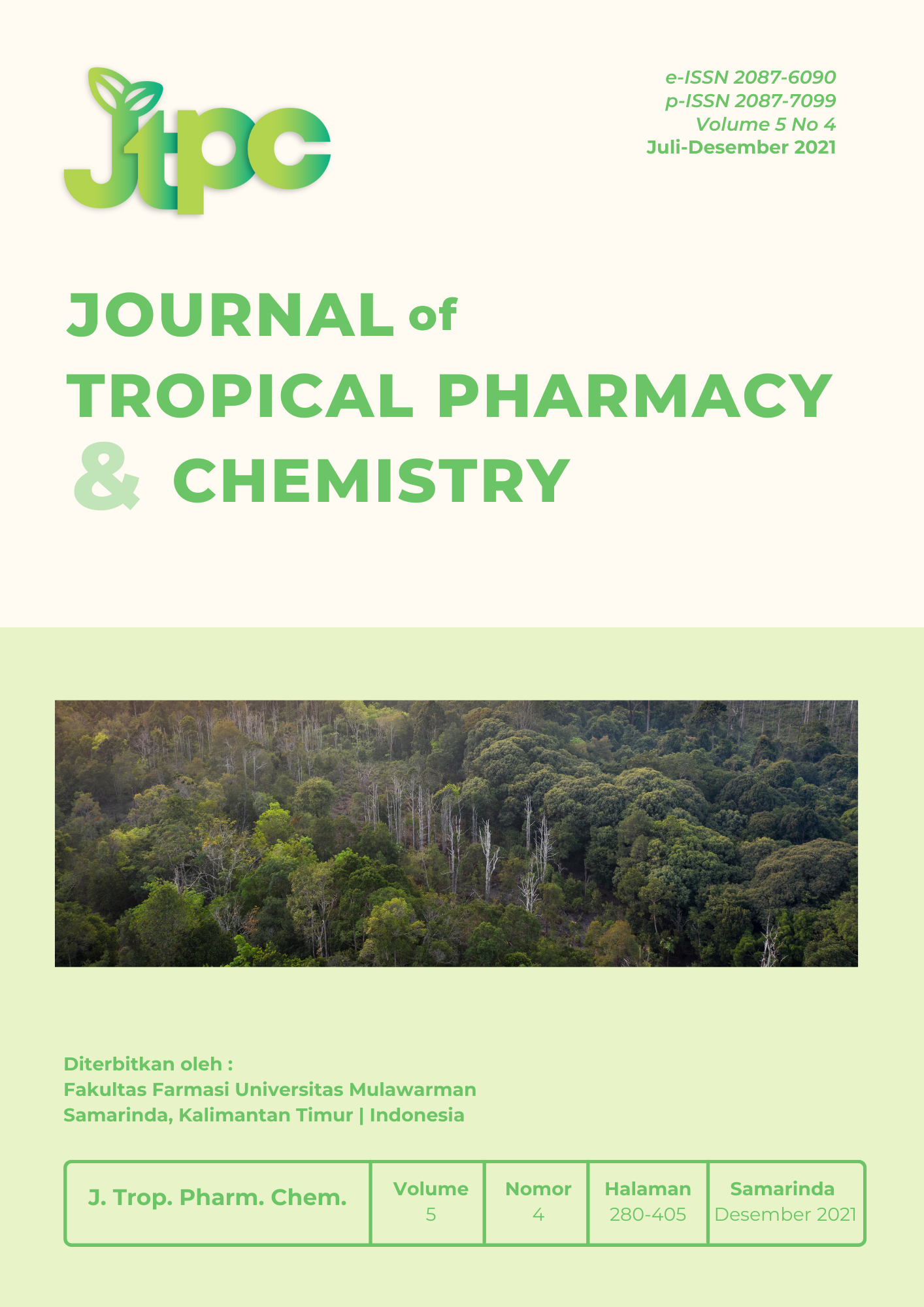Quality Control and Anti-Inflammatory Activity of the Stem Bark of Chlorophora regia A. Chev. (Moraceae)
DOI:
https://doi.org/10.30872/j.trop.pharm.chem.v5i4.253Keywords:
Chlorophora regia, Quality control, RP-HPLC, Anti-inflammatory, Regiafuran AAbstract
This study sought to develop a validated reverse-phase high-performance liquid chromatography method for the quality control of the stem bark ingredients and its finished products and investigate the synergistic anti-inflammatory activity of the phytochemical constituents of C. regia stem bark. Fractionation and isolation of biomarkers were carried out by column chromatography on silica gel and monitored by thin-layer chromatography. The isolated biomarkers were characterized based on their melting points and extensive analysis of their spectroscopic data (IR, 1D and 2D NMR). The chromatographic separation was investigated and developed for the analysis of the biomarkers using µBondapakTM C18 (3.9×300 mm, 5 µm) as stationary phase. The mobile phase composition of 0.1 % trifluoroacetic acid as solvent A, and methanol as solvent B with gradient elution was finally selected. The carrageenan-induced edema in a 7-day-old chick model was used to assess the anti-inflammatory activity of the stem bark extract and compared to diclofenac sodium as a reference drug. Two compounds were successfully isolated and identified, as Regiafuran A (1) and 3,5,7,4’-Tetrahydroxy-2’-methoxyflavonol (2). The compounds were employed as biomarkers in the RP-HPLC method development. The developed method was validated and was successfully used to quantify the amount of 1 and 2 in the stem bark to be 0.224% ± 0.056%w/w and 0.354% ± 0.041%w/w respectively. The crude extract showed considerable anti-inflammatory activity compared to the reference drug, diclofenac. The method demonstrated acceptable levels of accuracy, precision, specificity, and robustness hence can be successfully adopted for routine quality control and standardization of the stem bark of C. regia. The stem bark of the plant exhibited significant anti-inflammatory activity.
References
1. D.J. Newman, G.M. Cragg, Natural products as sources of new drugs over the last 25 years, J Nat Prod 70 (2007) 461-477.
2. R. Rajeswari, V. Prabhakaran, A. Saravanakumar, Phytochemical screening, gas chromatography-mass spectrometry profiling, in vitro cytotoxicity, and anthelmintic activity of hydroalcoholic extract of Duranta erecta leaves, Asian J Pharm Clin Res 13 (2019) 63-68.
3. World Health Organization, Traditional Medicine 2011 Report.
4. D. Manikandan, S. Parveen, P.A. Periasamy, Examination of phytochemical constituents – using seed extract of Madhuca longifolia, Asian J Pharm Clin Res 13 (2020) 35-37.
5. F.X. Liu, J. Salmon, Herbal medicine regulation in China, Germany, and the United States, Integr Med 9 (2010) 54-61.
6. Traditional Medicine Policy, Ministry of Health, Accra, Ghana, 2005.
7. D.A. Ofori, D. Louppe, A.A. Oteng-Amoako, M. Brink, (Eds), PROTA (Plant Resources of Tropical Africa), Wageningen, Netherlands, 2007.
8. J.O. Kyekyeku, S. Kusari, R.K. Adosraku, S. Zühlke, M. Spiteller, Prenylated 2-arylbenzofuran derivatives with potent antioxidant properties from Chlorophora regia (Moraceae), Fitoterapia 108 (2016) 41-47.
9. National Research Council. Guide for the care and use of laboratory animals: Eighth Edition. Washington, DC: The National Academies Press, 2011.
10. E. Boakye-Gyasi, E. Woode, G.K. Ainooson, D.D. Obiri, C. Ansah, M. Duwiejua, A. Donkoh, Anti-inflammatory and antipyretic effects of an ethanolic extract of Palisota hirsuta K. Schum Roots, Afr J Pharm Pharmacol, 2(9) (2008) 191-199.
11. W.K.M Abotsi, S.B. Lamptey, S. Afrane, E. Boakye-Gyasi, R.U. Umoh, E. Woode, An evaluation of the anti-inflammatory, antipyretic and analgesic effects of hydroeth-anol leaf extract of Albizia zygia in animal models, Pharm Biol 55(1) (2017) 338-348.
12. International Conference on Harmonization (ICH) 17, Topic Q2 (R1) Validation of analytical procedures: Text and methodology, (2005).
13. E. Woode, R.A. Poku, G.K. Ainooson, E. Boakye-Gyasi, W.K.M. Abotsi, T.L. Men-sah, A.K. Amoh-Barimah, An evaluation of the anti-inflammatory, antipyretic and an-tinociceptive effects of Ficus exasperata (Vahl) leaf extract, J Pharmaco Toxicol 4 (2009) 138-151.
14. M. Eddouks, D. Chattopadhyay, N.A. Zeggwagh, Animal models as tools to investigate antidiabetic and anti-inflammatory plants, Evid-Based Compli Alt (2012) 1–14.
15. M. Shibue, C.T. Mant, R.S. Hodges, Effect of anionic ion-pairing reagent concentra-tion (1-60 mM) on reversed-phase liquid chromatography elution behaviour of pep-tides, J of Chromatogr A 1080(1) (2005) 68-75.
16. M. Shaikh, A.P. Jadha,. Development and validation of RP-HPLC method for the simultaneous estimation of gallic acid, curcumin and piperine in an ayurvedic formula-tion, Int J Pharm Pharm Sci 12(6) (2020) 81-86.
17. P. Kaur, M. Kumar, U.T. Mandal, Development and validation of a simple HPLC method for estimation of mycophenolate mofetil in microemulsion formulation, Int J Pharm Pharm Sci 12(4) (2020) 16-20.


